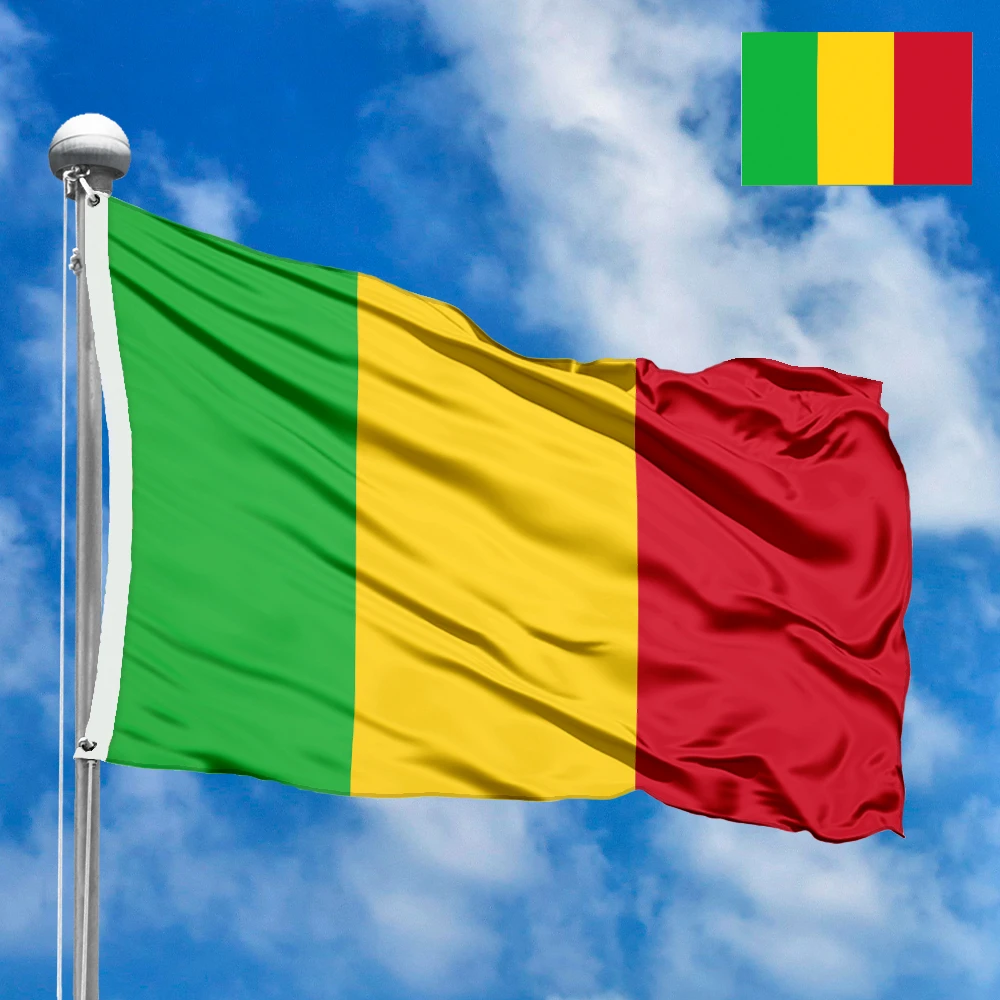The national flag of the Republic of Mali is a vibrant and deeply symbolic emblem, representing the nation's rich history, its commitment to independence, and its aspirations for a prosperous future. Adopted on March 1, 1961, the flag is a vertical tricolor, featuring three equally sized stripes of green, yellow, and red. These colors are not only aesthetically pleasing but also carry profound Pan-African significance, linking Mali to the broader movement for African liberation and unity. The flag encapsulates the hopes and struggles of a nation that emerged from colonial rule to forge its own path.
Design and Symbolism: A Palette of African Unity and National Values
The flag of Mali is a simple yet powerful design, consisting of three vertical bands of equal width:
-
Green (Hoist Side): The green stripe, positioned closest to the flagpole (hoist side), symbolizes several vital aspects of Mali. Primarily, it represents hope and the fertility of the Malian land, particularly its agriculture, which is the backbone of the economy. It also signifies the forests and natural resources of the nation. Beyond its natural connotations, green also embodies joy and a deep-seated respect for the environment and the country's natural heritage.
-
Yellow (Middle): The central yellow stripe is a radiant symbol of Mali's wealth. This includes the nation's rich mineral resources, such as gold, which historically played a significant role in the great Malian empires, as well as its other natural endowments. Yellow also represents the purity and spiritual values of the Malian people, signifying optimism, light, and the bright future that the nation strives for. It often evokes the sun, a source of life and energy.
-
Red (Fly Side): The red stripe, located on the outer edge (fly side), is a powerful tribute to the sacrifices made by the Malian people to achieve their independence from colonial rule. It represents the blood shed in the struggle for freedom and sovereignty. Furthermore, red symbolizes courage, valor, and the unwavering determination of the Malian people to defend their nation and uphold its hard-won liberty. It is a reminder of the revolutionary spirit that defined the nation's birth.
The use of these three colors together – green, yellow, and red – is a deliberate choice that reflects the Pan-African colors, first popularized by the flag of Ethiopia, the only African nation that largely avoided colonialization. By adopting these colors, Mali expresses its solidarity with other African nations and its commitment to the ideals of Pan-Africanism, including unity, self-determination, and shared prosperity across the continent.
Dimensions and Proportions:
The official proportions of the Flag of Mali are a width-to-length ratio of 2:3. This is a common standard for many national flags, providing a balanced and aesthetically pleasing appearance. Each of the three vertical stripes (green, yellow, and red) is of equal width, ensuring visual harmony and clear distinction between the symbolic colors. The simplicity of the design, combined with these standard proportions, makes the flag easily reproducible and recognizable.
History and Evolution: From Federation to Independent Republic
The history of the Malian flag is closely tied to its colonial past, its brief period as part of a federation, and its eventual emergence as a fully independent republic.
-
French Colonial Rule (Pre-1959): Before gaining autonomy and independence, Mali was part of French West Africa, and the French Tricolour (blue, white, red) was the dominant flag. There was no distinct Malian flag during this period.
-
Mali Federation (1959-1960): In 1959, the French Soudan (which would become Mali) and Senegal united to form the Mali Federation. This federation adopted a flag that was a vertical tricolor of green, yellow, and red, identical to the current flag of Mali, with one crucial difference: a black stylized human figure (a djenne or kanaga, representing a stylized human or bird from indigenous African art) was placed in the center of the yellow stripe. This figure symbolized the African people and their unity.
-
Dissolution of the Federation and Adoption of the Current Flag (1960-1961): The Mali Federation was short-lived, dissolving in August 1960 when Senegal withdrew. The former French Soudan then declared its full independence as the Republic of Mali on September 22, 1960. Initially, the new independent Mali continued to use the federation's flag. However, on March 1, 1961, the black djenne figure was removed from the flag. This decision was influenced by the strong Islamic faith of a significant portion of the Malian population, as the depiction of human forms is often discouraged in some interpretations of Islam. The removal of the figure also simplified the flag, making it purely a Pan-African tricolor.
-
Post-Independence: Since its adoption in 1961, the flag of Mali has remained unchanged, serving as a consistent symbol of the nation's sovereignty, its commitment to Pan-African ideals, and its internal values.
Regional Context and West African Identity:
Mali is a landlocked country in West Africa, bordering Mauritania, Algeria, Niger, Burkina Faso, Côte d'Ivoire, Guinea, and Senegal. Its flag fits perfectly within the broader tradition of Pan-African symbolism, particularly prevalent in West Africa. The use of green, yellow, and red is a common theme among flags of nations that gained independence in the mid-20th century, signaling a shared heritage of colonial struggle and a common aspiration for African unity and prosperity.
Countries like Guinea, Senegal, and Cameroon, among others, also feature these colors in various arrangements, signifying their solidarity and shared post-colonial identity. Mali's flag, through its adherence to the Pan-African color scheme, firmly places it within this regional narrative of self-determination and continental solidarity. While many West African flags share these colors, Mali's specific vertical arrangement without additional emblems (after 1961) offers a distinct, yet harmonizing, presence within the regional vexillological landscape.
Interesting Facts:
-
Pan-African Colors: The green, yellow, and red colors are the traditional Pan-African colors, symbolizing African unity and independence.
-
Shared History with Senegal: The initial flag of the Mali Federation (1959-1960) was almost identical to the current flag, but it included a black human figure (kanaga) in the yellow stripe.
-
Islamic Influence on Design Change: The kanaga figure was removed in 1961 partly due to religious objections from some Islamic communities in Mali against the depiction of human forms.
-
Simple Yet Profound: Despite its simple design, each color holds deep symbolic meaning related to the nation's land, wealth, and sacrifices.
-
Adopted Post-Independence: The current flag was adopted shortly after Mali gained full independence, establishing a new national identity.
-
One of the Largest Countries in Africa: Mali is one of the largest countries in Africa by land area, contributing to its diverse geography represented by the green stripe.
-
Historical Empires: The yellow stripe alludes to Mali's rich history, particularly the ancient Malian Empire, famous for its vast gold reserves.
-
Symbol of Continuity: The flag has remained unchanged since 1961, providing a consistent symbol of national identity and stability.
Significance for the Inhabitants: A Banner of Resilience, Progress, and Unity
For the people of Mali, their national flag is a source of immense pride and a powerful reminder of their journey from colonial subjugation to independent nationhood. It is a symbol that resonates deeply with their collective memory, their daily lives, and their aspirations for a better future.
The green stripe represents the land that sustains them – the fertile fields, the natural beauty, and the promise of agricultural prosperity. It connects Malians to their rural roots and the fundamental importance of working the land. It evokes a sense of hope and joy for what the future holds, rooted in the nation's natural abundance.
The yellow central stripe speaks to the richness of their heritage and the potential for economic advancement. It reminds them of the legendary wealth of historical Malian empires, particularly their gold, fostering a sense of pride in their past and optimism for future development. It also embodies the spiritual light and purity that guide their communal life.
The red stripe carries the solemn weight of sacrifice and the enduring spirit of resistance. It is a powerful tribute to those who fought and died for Mali's freedom, serving as a constant reminder of the value of independence and the need for vigilance in defending it. This color instills a sense of courage and unity, reminding Malians that their nation was built on struggle and determination.
Together, the Pan-African colors foster a strong sense of solidarity with the broader African continent, emphasizing Mali's role in the larger narrative of African liberation and unity. When displayed, whether at national celebrations, school events, or in local communities, the flag serves as a unifying emblem. It transcends ethnic and regional differences, bringing Malians together under a shared symbol of their resilience, their collective aspirations for progress, and their unwavering commitment to building a peaceful and prosperous nation. The flag is a living testament to their history, a beacon for their future, and a cherished emblem of their unique identity.
In the demonstration images, full-size flags are shown with proportions of 2:3, and hand-held flags with proportions of 1:2.






 Waving flag
Waving flag
 Sizes:
Sizes:
 Round flag
Round flag
 Sizes:
Sizes:
 Rectangular flag 2:3
Rectangular flag 2:3
 Sizes:
Sizes: